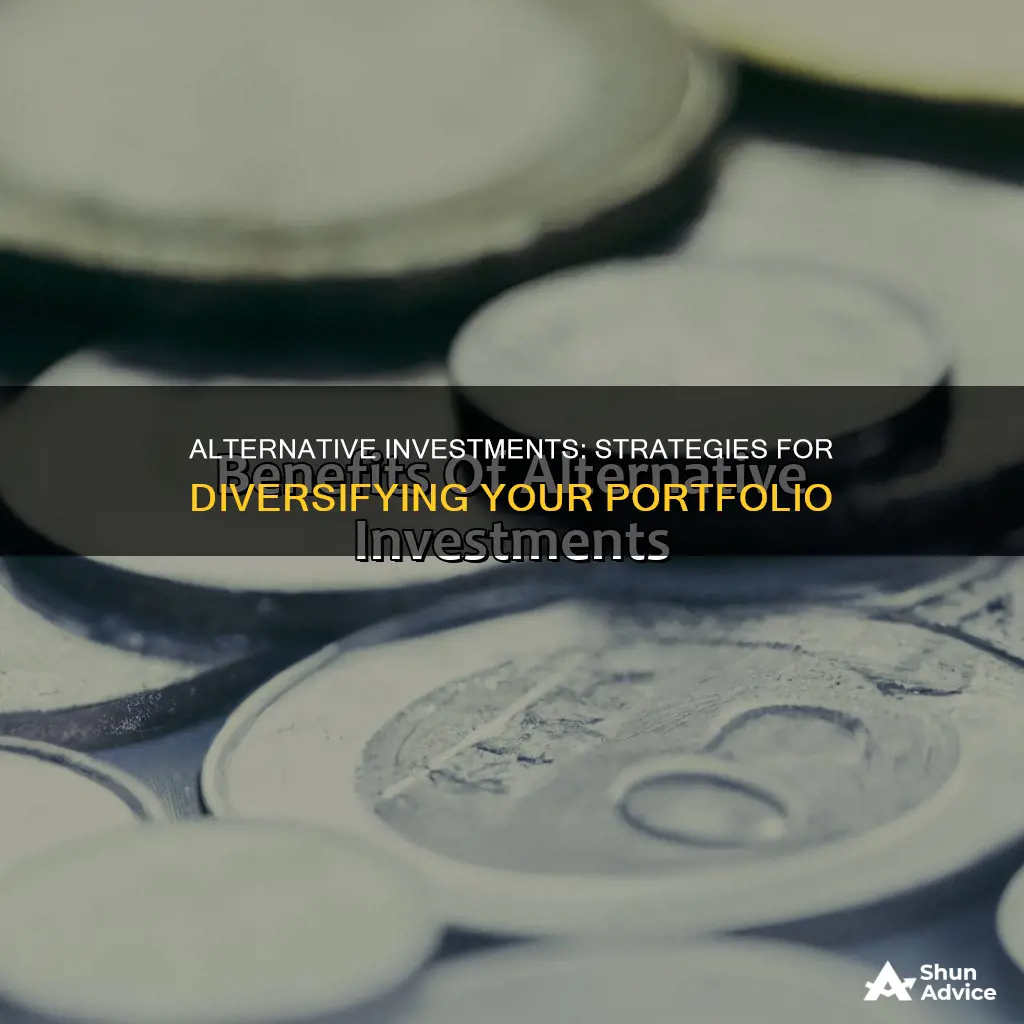
Alternative investments are financial assets that do not fall into conventional categories such as stocks, bonds, or cash. They include private equity, venture capital, hedge funds, real estate, commodities, and cryptocurrencies. These investments are often less liquid and more complex than traditional investments, but they can provide greater diversification and the potential for higher returns. When considering alternative investments, it is essential to assess your financial goals, risk tolerance, and timeline. While alternative investments offer attractive opportunities, they also come with higher risks and may have complex fee structures and tax implications.
| Characteristics | Values |
|---|---|
| Regulation | More lightly regulated by the US Securities and Exchange Commission (SEC) than traditional investments |
| Liquidity | Illiquid |
| Correlation to standard asset classes | Low |
| Risk | Higher risk than traditional investments |
| Returns | Higher potential returns than traditional investments |
| Accessibility | More accessible to retail or individual investors |
| Investor type | Institutional investors or accredited, high-net-worth individuals |
| Fees | Higher fees and expenses compared to traditional investments |
What You'll Learn

Private equity
There are several subsets of private equity:
- Venture capital focuses on startup and early-stage ventures.
- Growth capital helps more mature companies expand or restructure.
- Buyouts involve purchasing a company or one of its divisions outright.
An important aspect of private equity is the relationship between the investing firm and the company receiving capital. Private equity companies often provide more than just capital to the firms they invest in. They may also offer industry expertise, talent sourcing assistance, and mentorship to founders.
Understanding Initial Investment Outlay: First Cash Outlay Explained
You may want to see also

Hedge funds
When investing in hedge funds, it is important to note that they are only available to accredited investors, who must have a high net worth and a substantial amount of investment capital. Investors can access hedge funds through hedge fund managers or brokers.
Python in Investment Banking: A Common Tool?
You may want to see also

Real assets
- Precious metals, such as gold and silver
- Commodities, including agricultural products, oil, and natural gas
- Real estate, including physical properties and property-based securities
- Land, such as timberland and farmland
- Equipment and machinery
- Natural resources
Strategies for Investing Cash Without IRS Attention
You may want to see also

Commodities
There are several ways to add commodities to your portfolio:
- Commodity futures: A futures contract is a legal agreement to buy or sell a commodity at a predetermined price and time.
- Physical commodities: Investors can purchase physical commodities such as cattle or oil, or precious metals like gold bullions or coins.
- Commodity stocks: Investors can buy stock in commodity-producing companies.
- Commodity ETF (exchange-traded fund): This provides exposure to a range of commodity producers.
- Commodity mutual fund: This provides exposure to the commodity market while avoiding some of the risks of commodity futures.
- Hedge funds: Hedge funds often invest in a variety of commodities and use different financial instruments.
It is important to note that commodities are highly volatile and unpredictable, and their prices can be influenced by various external factors such as weather conditions, geopolitical events, and supply and demand dynamics. They are also considered environmentally unfriendly and do not generate revenue or pay dividends.
Etrade Cash Availability: Why Can't I Invest?
You may want to see also

Collectibles
Art, antiques, stamps, books, coins, trading cards, toys, and comic books are common types of collectibles. Rare collectibles often fetch higher prices, and the value of collectibles tends to appreciate over time. For example, a stainless steel sculpture by Jeff Koons sold at auction for a record-breaking $91.1 million in May 2019. On the other end of the spectrum, some mass-produced items have become collectibles, such as Beanie Babies.
Nostalgia also plays a role in a collectible's value. Nostalgia cycles tend to arrive in 20- to 30-year waves. That is to say, something that's popular now has the potential to become a collectible two or three decades later as people seek to reconnect with their past.
There are several advantages to investing in collectibles. Firstly, they may provide your portfolio with diversification. It's always helpful to have your eggs in more than one basket, rather than investing only in stocks and bonds. Secondly, collectibles are physical assets that you can hold in your hand or transport easily, so you can sell or trade them anywhere in the world. Thirdly, investing in collectibles can be fun, as true collectors revel in the thrill of the hunt. Finally, collectibles are relatively easy to access through online marketplaces such as eBay or in local stores, and you may even be able to pick up valuable items at yard sales, thrift stores, or pawn shops.
However, there are also several downsides to investing in collectibles. Firstly, the collectibles market is rampant with fraud, as it is an unregulated industry full of fakes and forgeries, and even experts can be fooled by convincing knock-offs. Secondly, collectibles dealers are known for marking up items so they can make a profit, and you may have to pay overhead costs such as storage, maintenance, and insurance. Thirdly, a collectible's value depends largely on its condition and rarity, and any scratch, ding, or blemish can cause its value to decline or become worthless. Fourthly, collectibles are largely illiquid, as cashing out depends on your ability to find a buyer willing to pay your asking price.
Before investing in collectibles, it's important to be aware of the associated tax implications. In the US, if you've owned a collectible for more than a year, it may be subject to a maximum long-term capital gains tax of 28% when you sell it. That's notably higher than the 15% capital gains tax for traditional investments like stocks and bonds. If you sell a collectible after owning it for less than a year, you'll be taxed at your ordinary income tax rate.
Overall, collectibles can be a risky and speculative investment option that requires in-depth research and experience to be successful. They should only make up a small portion of your overall investment portfolio—generally recommended to be no more than 5% to 10%.
Maximizing Your Spare Cash: Smart Investing Strategies
You may want to see also
Frequently asked questions
Alternative investments are financial assets that do not fall into conventional investment categories such as stocks, bonds, or cash. They include private equity, private credit, infrastructure, private real estate, hedge funds, commodities, and cryptocurrencies.
Alternative investments offer greater portfolio diversification, potentially higher returns, and reduced overall risk. They are also less correlated with traditional investments, meaning they can help protect your portfolio during market downturns.
Alternative investments are typically less liquid, have higher fees, and may have long lock-up periods. They are also often complex and carry a higher risk of loss. Due to their limited regulation, they may be prone to investment scams and fraud.







